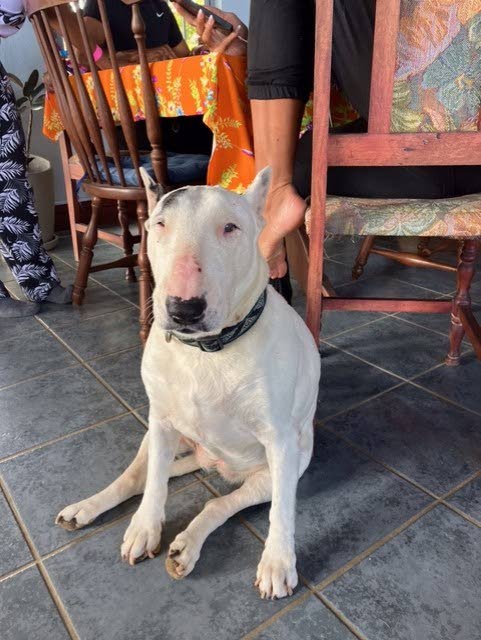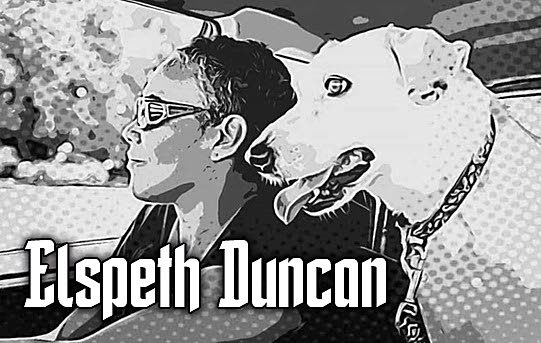Think like a dog to find 'Betsy' (or any lost dog)

Whenever a dog is reported "lost" my heart goes out to the dog and to the humans who care about him/her.
While some may wonder what the fuss is about (“It’s just a dog”), to people who love their pets, having one go missing can be akin to the trauma experienced by people whose human loved ones ‘disappear’.
About two weeks ago, I saw a "missing dog" Facebook post written by "friends of a friend." Betsy, their much-loved English Bull Terrier, had disappeared into the stormy night after a house guest opened the door to a room in which she was secured. The family pet (easily traumatized by loud noises) bolted into the thunderous night. She has not been seen since, despite searches in the remote forested area around her home (Fond Pois Doux Road along the North Coast) and environs.
The almost daily Facebook posts from her "humans’ are heartbreaking – “she is very missed and loved”; “friendly, 63lbs, spayed, cannot be used for breeding”; “Please keep her in your hearts and minds”; “I’m begging you again to please share so we can get our Betsy back”; “If you have her, please take her to the vet and get a prescription for dry eye as she needs drops twice a day. Also she is a timid girl and reacts to loud noises, fireworks and bad weather, so will need a prescription for CBD oil. Please do this immediately to keep her healthy and please be kind to her.”

Quite often when looking for a missing dog, we humans rely primarily on our visual sense, for example, “Is this the dog I saw on that ‘Lost’ poster?”
In contrast, dogs are blessed with almost "super" senses, empowering them with remarkable homing instincts. Therefore, catering to dogs’ senses (mainly the auditory and olfactory) and not just relying on ours (mainly visual) could lead to greater success in relocating them.
With a sense of smell approximately100,000 times more powerful than ours, in ideal conditions a dog can detect a person or object from as far as twelve miles (approximately 20 km) away.
Furthermore, their highly developed olfactory sense enables them to "read" specific details, for example, by sniffing another dog they can determine gender, personality, health condition, where he/she has been and what he/she may have eaten. When they stop to smell, they are gathering data on other animals and people who have been in the area.
The unique structure of the canine nose makes it a compass of sorts. The nasal cavity is divided into two separate chambers, connected to two nostrils which can move independently, allowing the dog to identify the nature and direction of separate smells at the same time.
With such advanced olfactory apparatus, it is no wonder that trained dogs can detect anything from the seemingly "un-sniffable" (e.g. past events, stress, emotions, cancer, epilepsy, covid19 and other diseases) to more common sniffer-dog elements (e.g. bombs, guns, drugs, human remains, bodies trapped in rubble).
The dog’s auditory capacity must also be catered to in our searches. Multiple ear muscles enable dogs’ ears to rotate and perk up, sometimes independently of each other. This, in addition to the tilting of their heads when listening, enables them to detect more precisely the nature and direction of sounds—such as the familiar voice of their ‘human’ which can lure them even more strongly than scent or vision might.
Based on the above, I suggest the following:
1. Record the voice of the dog’s "human" calling the dog. Use a Bluetooth speaker to play this on full volume while searching. I employed this method once with a lost rescue dog (searchers played the mp3 loudly while penetrating dense bushes in the Maracas Valley area). It is possible that this could have played a role in helping the dog navigate his way back home.
2. Hang or place worn, strongly-familiar scented pieces of clothing or shoes in the immediate area and environs, forming an olfactory trail that leads back to the home.
3. View this video for tips on correct ways to approach a lost dog: https://tinyurl.com/safely-catch-lost-dog
If you spot Betsy, please secure her safely and immediately WhatsApp 374-8906 along with a photo you have taken of her, to ensure authenticity.
May she soon be returned, alive and well, to her loving family.


Comments
"Think like a dog to find ‘Betsy’ (or any lost dog)"